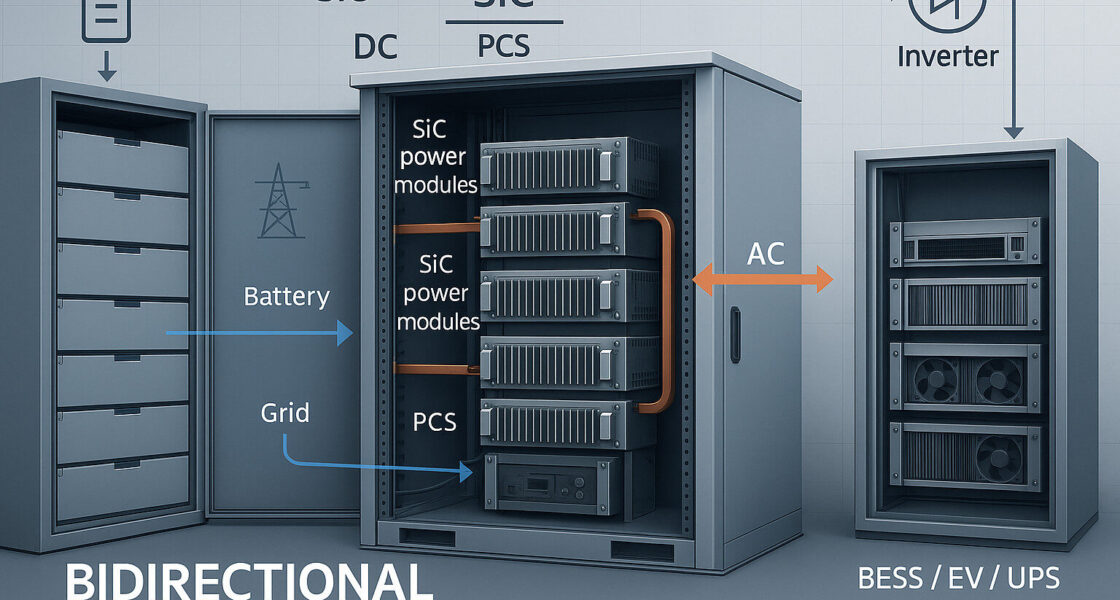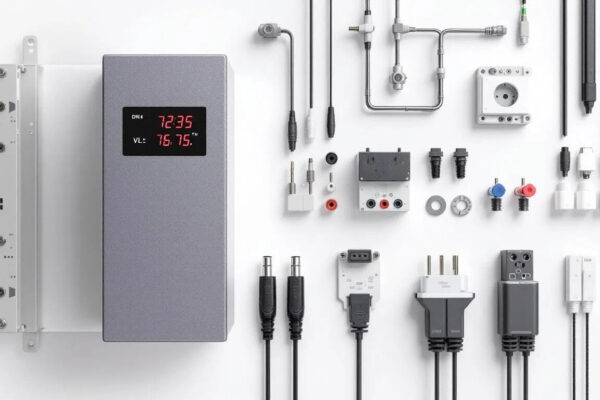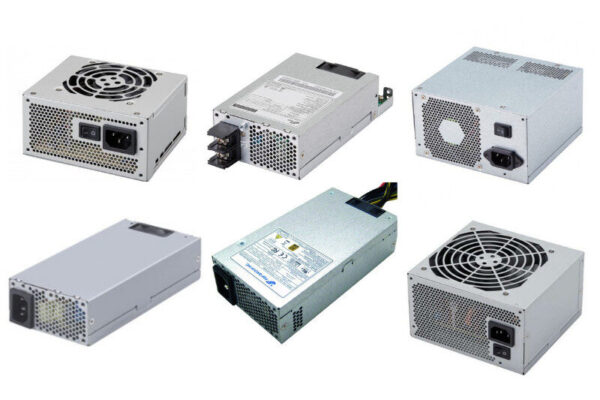Introduction: Why Bidirectional Power Modules Matter
Bidirectional power modules convert AC↔DC in both directions, enabling two-way energy flow for storage, EV charging and V2G, microgrids, and renewable systems.
Compared with one-way supplies, they combine AC-DC conversion and DC-AC inversion with power-factor correction (PFC), harmonic mitigation, and coordinated control—recovering energy, stabilizing power, and improving efficiency.
This guide explains their working principles, key design features, main applications, and customization paths.

How Bidirectional Conversion Works
AC-to-DC Conversion (AC-DC)
Most devices—from sensors to drives—require DC. AC-DC stages convert grid AC (e.g., 176–264 VAC) into regulated DC.
Main stages
- Rectification: Diode bridge or synchronous rectifier converts AC to pulsating DC.
- Filtering: Capacitors/inductors smooth ripple for stable DC.
- Regulation: Control electronics set the output (e.g., 12 V, 24 V, 48 V, or HVDC).
High-efficiency designs often combine synchronous rectification, resonant (e.g., LLC) topologies, and digital control to minimize losses.
Key metrics
- Efficiency: lowers heat and operating costs
- Power factor (PF): alignment of current and voltage
- Total harmonic distortion of current (THDi): indicator of power-quality impact
High PF and low THDi support compatibility with relevant EMC and grid standards (IEC 61000-3-2/-12, IEEE 519, etc.—applicability depends on rating and connection type).
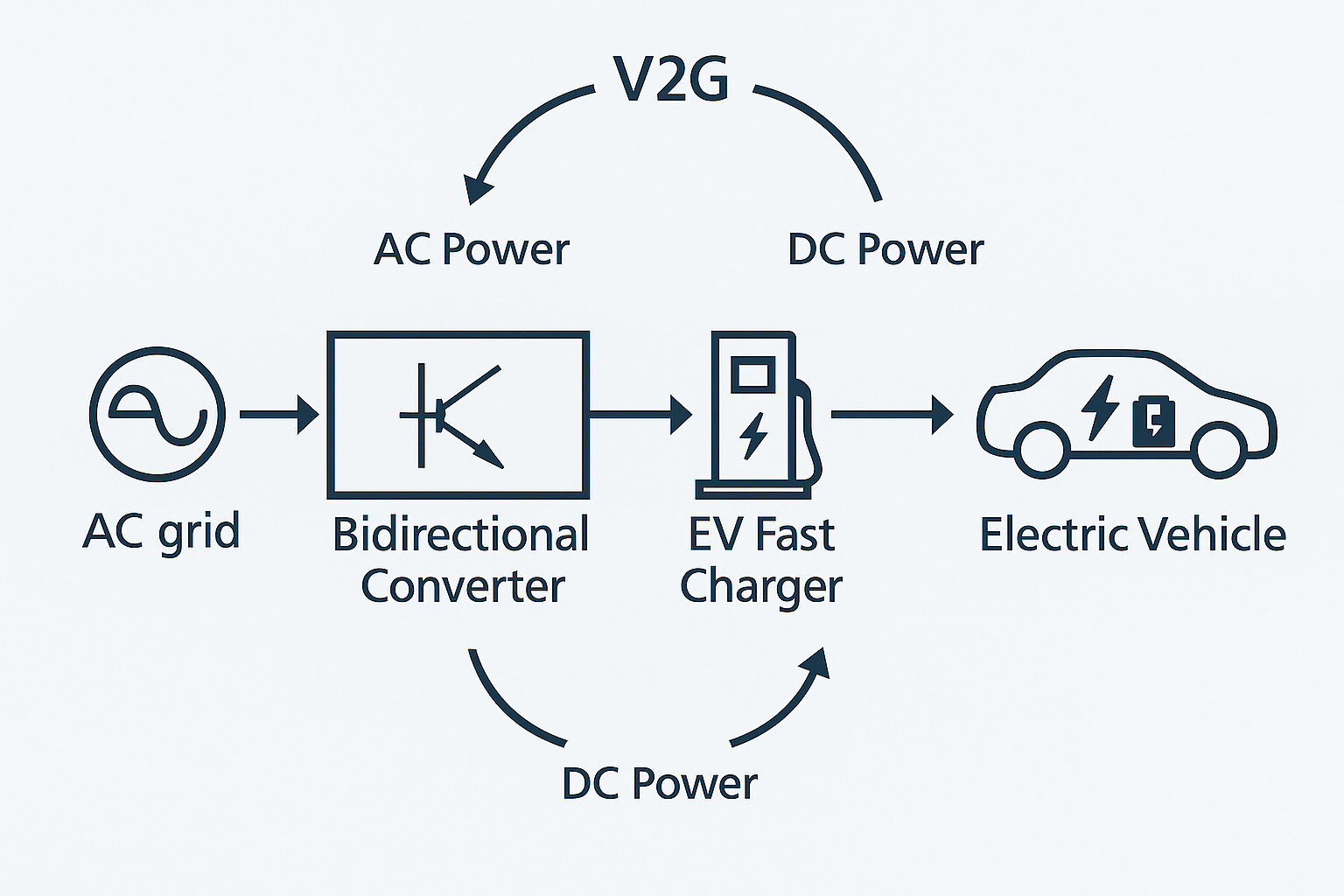
DC-to-AC Conversion (DC-AC)
Inverters convert stored or generated DC (from batteries, PV, or fuel cells) into grid-compatible AC.
Typical stages
- Inversion (PWM): Fast switches (e.g., MOSFETs, IGBTs, SiC MOSFETs) synthesize an AC waveform.
- Filtering & synchronization: Output filters remove switching components; synchronization aligns frequency, voltage, and phase for safe grid-tied operation.
A major advantage is energy recovery—surplus DC (e.g., regenerative braking or test benches) can be converted to AC and fed back to the grid or reused on-site.
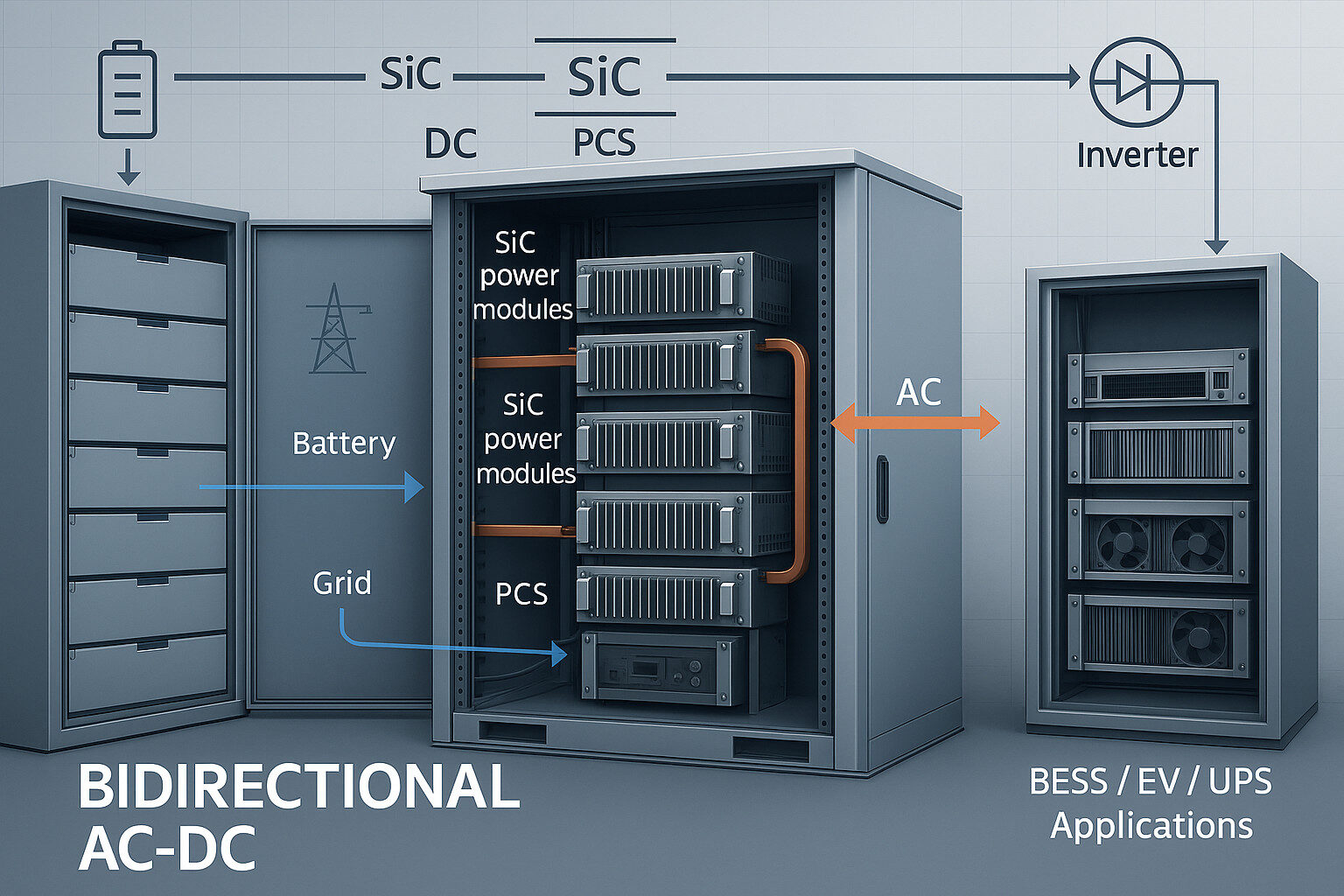
Bidirectional Operation (AC↔DC)
A bidirectional architecture merges both directions under coordinated control, enabling:
- Charging (AC→DC): Store energy in batteries during off-peak or high-renewable periods.
- Discharging (DC→AC): Supply loads or feed the grid during peaks.
- Energy recycling: Capture regenerative energy and reuse it.
Parallel-capable modules allow scaling from a single unit to multi-hundred-kilowatt systems.
Key Design Features
High-Efficiency AC-DC Stage (up to ≈93.5 % typical)
High efficiency reduces thermal stress and operating cost, especially in continuous or high-power use.
Typical enablers include synchronous rectification, resonant (e.g., LLC) topologies, and digital control that optimizes switching across line/load conditions.

Fast Mode Switching (ms-class, e.g., < 10 ms typ.)
Rapid transitions between AC-DC and DC-AC avoid interruptions in dynamic applications such as UPS, grid support, or EV/V2G.
Enabled by fast semiconductors (e.g., SiC MOSFETs), predictive control, and robust sensing.
Energy Recycling
In EV, industrial drive, or test applications, regenerative energy on the DC link can be converted to usable AC or stored again—reducing net energy draw and thermal dissipation.

Power Quality: PF and THDi
-
PF ≈ 1 via active PFC minimizes reactive current.
-
THDi ≤ 5 % (where applicable) limits harmonic injection.
Techniques include multi-level inversion, passive/active filtering, and digital harmonic compensation.
These support compliance with IEC 61000-3-2/-12 and IEEE 519 (depending on grid and rating).
Parallel Operation (up to 8 units)
Multiple modules can run in parallel using master–slave or droop control for ±1 % current balance, CAN-based synchronization, and redundancy for continued operation if one unit goes offline.
Wide Input Range (176–264 VAC)
A broad input range ensures stable operation in fluctuating grids. Typical measures: boost-type PFC for DC-link stability, under/over-voltage protection, and temperature-rated components for harsh environments.
Representative Applications
Renewable Energy & Microgrids
Bidirectional modules link solar, wind, and storage systems for self-consumption, peak-shaving, and export.
High efficiency boosts yield, and PF/THDi compliance eases grid integration.
Example: A 500 kW PV site uses five 100 kW modules in parallel to charge/discharge a battery and export AC. During cloudy periods, the storage supports loads or grid services.
EV Charging & V2G
Bidirectional systems combine fast charging (AC→DC) and vehicle-to-grid operation (DC→AC) on one platform.
Fast switching supports grid-service events, and energy recovery reduces waste during dynamic charging.
Example: A station with four 100 kW modules supports multiple fast chargers and can provide demand-response power when vehicles opt in.
Industrial Automation & Test Benches
Provides stable DC buses for robots and drives while recovering energy during deceleration.
Parallel operation enables high-power test conditions, and low THDi avoids interference with sensitive control systems.
Data Centers & UPS
Bidirectional conversion enables lithium-ion UPS systems with ms-class transfer and optional energy recovery within the power chain.
Parallel scalability matches facility growth.
Use “designed for uninterrupted transfer within typical IT ride-through limits (e.g., < 10 ms)” instead of “zero downtime.”
Customization Options
Available adaptations
-
Input/output ranges (e.g., 90–264 VAC, 12 V to HVDC, higher current ratings)
-
Form factors (compact/mobile, rack-mount, IP-rated)
-
Compliance & certifications (medical IEC 60601-1/-1-2, automotive ISO 16750, ATEX/IECEx; project-dependent)
-
Control & communication (Modbus TCP, CANopen, Ethernet/IP, analog/digital I/O)
-
Special features (isolation schemes, enhanced EMI filtering, integrated BMS)
Typical project flow
-
Requirements & feasibility
-
Design & simulation
-
Prototyping & verification (efficiency, switching, environmental)
-
Manufacturing & quality control (traceability)
-
Delivery, commissioning & support
Example (Medical):
A compact 1 U, 48 V / 50 A supply with reinforced isolation and low leakage current can be developed for medical use, targeting IEC 60601-1/-1-2 compliance. (Final performance and certification depend on the approved design.)
FAQs
Q1 – What’s the difference between AC-DC and DC-AC in one bidirectional module?
AC-DC converts grid AC to regulated DC for loads or charging. DC-AC inverts DC to AC for loads or export. The bidirectional platform integrates both with coordinated, safe, fast switching.
Q2 – Can it work with solar or wind?
Yes. PV provides DC that can be stored or inverted; wind usually provides AC that can be rectified or supplied directly. Grid-tied use must follow local grid codes and EMC standards for the rated power.
Q3 – How does energy recycling help in industry?
Regenerative energy from drives or test stands can be recovered instead of wasted as heat—reducing net energy draw and cooling demand. Savings depend on duty cycle and system design.
Q4 – How does parallel operation improve reliability?
Modules share current; if one goes offline, others continue within their limits. Hot-swap maintenance can further reduce downtime.
Q5 – Can you support sector-specific compliance (e.g., medical)?
Yes—based on a defined specification and certification plan. Isolation, leakage current, and EMI designs are tailored to each standard.
Conclusion: Where Bidirectional Modules Fit Best
Bidirectional power modules bring flexibility (AC↔DC), high efficiency, power quality, and scalable architecture to microgrids, storage, EV infrastructure, industrial systems, and UPS applications.
Combined with proper control, protection, and compliance design, they form a robust foundation for modern energy management.

